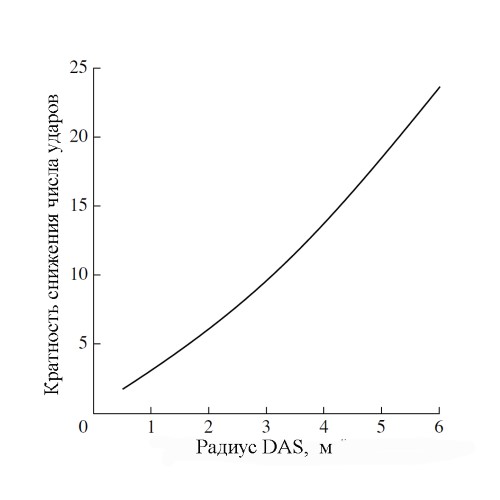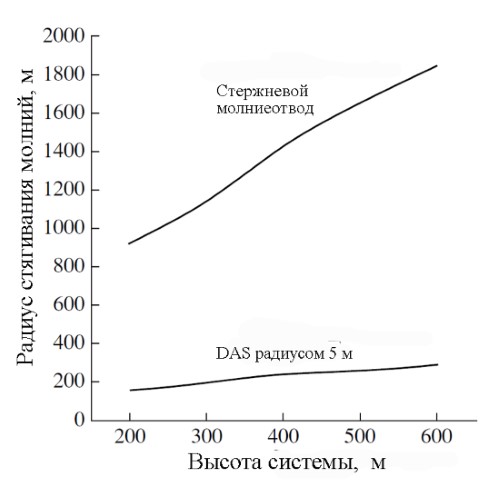Dissipation array device is a modern lightning protection system, successfully used worldwide at a wide variety of sites: tank farms, airports, factories, power plants, nuclear power plants, offshore platforms, telecommunication towers and other.
The designers of Russia and the CIS countries have shown a growing interest in this system, but in an attempt to learn its peculiarities they are not always getting answers to all the questions.
This article by Professor Eduard Meerovich Bazelyan is intended to answer, perhaps, the main question about the system of dissipation array system - is it really efficient?

E. M. Bazelyan, DEA, professor;
Power Engineering Institute to the name of G.M. Krzyzanowski , Moscow;
recognized Russian expert in the field of grounding and lightning protection.
There are two aspects in this task. The first concerns the work of a dissipation array device as an ordinary lightning rod in relation to the site it shelters. In this respect, it is perfect. The site, entirely covered with metal structures of the dissipation array device, is absolutely protected from direct lightning strikes. Another issue is connected with the suppression of lightning strikes directly in the dissipation array device. Today it is a very important task, because a lightning strike into a dissipation array device will be accompanied by the spread of the lightning current over its metalwork, which will cause excitation of EMF magnetic induction in the communications of the protected site. It is obvious that we can't talk about an absolute reliability, because lightning can strike into the dissipation array device, despite the absence of a counter-leader, just as it strikes at any other point that doesn't stand out on the flat surface of the earth. And the fact of the suppression of the counter-leader is probably not carried out with 100% probability. The smaller is the horizontal displacement of the downstream lightning leader channel relative to the vertical axis of the dissipation array device, the greater it will strengthen the electric field during its decline. Eventually the field may exceed the ionization threshold (about 3 × 106 V / m) on the entire surface of the dissipation array device with the radius of several meters. Under such conditions, a streamer flash is inevitable and will certainly initiate a counter-leader. The corona needle swill no longer perform their protective function.

Fig. 1
To the evaluation of the protective action of a dissipation array device
Кратность снижения числа ударов –number of strikes reduction multiplicity
Радиус DAS – DAS radius
As a result, the number of hazardous effects of electromagnetic fields from nearby lightning strikes reduces accordingly. A conventional lightning rod is not capable of that at all.

Fig. 2
Dependence of the equivalent radius of lightning contraction on the height of the object
Радиус стягивания молний, м – lightning contraction radius, m
Стержневой молниеотвод – rod lightning rod
Das радиусом 5 м – DAS with a radius of 5 m
Высота системы. М – System height, m
Another fundamental feature of a dissipation array device, that conventional land structures do not possess, should be noted. With the existing estimations, the equivalent radius that defines the area of lightning contraction Reqv, is approximately proportional to the height of the object h (this expression is often used Reqv, ≈3h). This kind of dependence is very weak for a dissipation array device (fig. 2). This circumstance makes a dissipation array device an effective protection mean of concentrated high-rise buildings. For example, installation of a dissipation array device of a radius of 5 m above the Ostankino TV tower would allow to reduce the Reqv, from 1600 to 250 meters, which would reduce the number of its lightning injuries in about 40 times
Undetermined problems
We can not say that a dissipation array device made a triumphant march to the world market of lightning protection products, but still maintained the number of the used structures has been long counted by thousands of samples. We should focus on the two main reasons of a not too rapid implementation of dissipation array device into practical lightning protection. The first of them, and perhaps the main, has nothing to do with technology and is only related to human psychology. In due time there were many hasty reviews of well-known specialists in the scientific literature. They tried to forget about their judgments which were not always justified, but did that in silence, without public explanation of their attitude to the real state of affairs. The second reason is directly related to the features of a dissipation array device. The sphere of its application mainly covers structures - antenna masts, high supports of lighting systems, towers and similar objects of a great height. In their relation, a dissipation array device operates as an umbrella. It covers the object from direct lightning strikes. And performs another function, which is very important in the age of microprocessor technology. A dissipation array device becomes a hide-away hat, not allowing lightning to distinguish itself and the protected site from any significant distance. Thus, close lightning strikes and the consequences of their dangerous electromagnetic influences are significantly eliminated. However, the concept of the protection zone can't be applied to the dissipation array device. It is known that the sheltered site is perfectly protected from a direct impact, but it is not known at what distance from the dissipation array device the protective effect remains. This question requires a detailed study, which has not even been planned.
E. M. Bazelyan, DEA, professor
Energy Institute named after G.M. Krzyzanowski, Moscow
See also:

